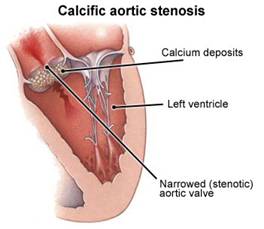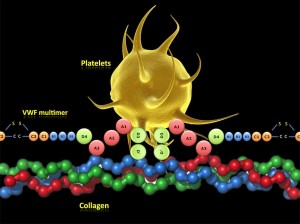Impact-R and Acquired von Willebrand Disease in Severe Aortic Stenosis
Wednesday, December 21st, 2011The aortic valve is the valve between the left ventricle and the aorta, the main artery. It has three leaflets (tricuspid). When the left ventricle contracts, it pushes blood through the valves and into the aorta. When the left ventricle relaxes, the valves close, preventing the blood from flowing back into the left ventricle.
 When the aortic opening becomes constricted or stenotic, the blood in the left ventricle cannot be pumped effectively into the aorta. Aortic stenosis (AS) is usually age-related and is caused by progressive calcification of any of the three leaflets of the valve.
When the aortic opening becomes constricted or stenotic, the blood in the left ventricle cannot be pumped effectively into the aorta. Aortic stenosis (AS) is usually age-related and is caused by progressive calcification of any of the three leaflets of the valve.
Severe aortic stenosis also causes an acquired form of von Willebrand disease (vWD type 2A). This is due to breakdown of the von Willebrand factor (vWF) by the increased turbulence around the stenotic valve. The increased turbulence causing high shear stress conditions predisposes the vWF to cleavage by an enzyme, ADAMTS-13. This enzyme is the 13th member of the class of enzymes known as a disintegrin and metalloproteinase with a thrombospondin type 1 motif also known as von Willebrand factor-cleaving protease (vWFCP).
 This acquired form of vWD causes bleeding in the AS patient. Whether the bleeding is due to platelet adhesion or to platelet aggregation has not been determined. This is the subject of the study done by Panzer, et.al. using the IMPACT-R machine. The study concludes that reduced levels of large vWF multimers associated with severe AS leads to impairment of both adhesion and aggregation of platelets. An abstract of the study can be found here.
This acquired form of vWD causes bleeding in the AS patient. Whether the bleeding is due to platelet adhesion or to platelet aggregation has not been determined. This is the subject of the study done by Panzer, et.al. using the IMPACT-R machine. The study concludes that reduced levels of large vWF multimers associated with severe AS leads to impairment of both adhesion and aggregation of platelets. An abstract of the study can be found here.